Many aspects of our world offer compelling ways to see our deep time history, Ancestors, and often similar ways to think about future generations. For me, total solar eclipses are a wonderful case of this. Total solar eclipses are not common. In any given place (say, the Sphinx of Egypt, Mt. Fuji in Japan, or the Yucatan Peninsula, etc.), one needs to wait usually many centuries from one to the next total solar eclipse. For me here in Detroit, Michigan (which will be missed by the path on April 8th), the most recent total solar eclipse was in 1806, and the next one is in 2444, a wait of over 600 years! What if it were possible, when a total solar eclipse happens, to look from one’s current time and place, to see out into another time and place when a total solar eclipse happened or will happen? An eclipse portal?
 As with so much in our world today, science can bring us some ability to do exactly this. We now know so much more about past times and our Ancestors, that you and I can often look up enough info to get a good idea of much of what you’d see if you could look through a literal eclipse portal. I find it incredible to realize how much more we know now about life in so many ancient times compared to even our great-grandparents! Plus, we know when and where total solar eclipses happened, going back thousands of years!
As with so much in our world today, science can bring us some ability to do exactly this. We now know so much more about past times and our Ancestors, that you and I can often look up enough info to get a good idea of much of what you’d see if you could look through a literal eclipse portal. I find it incredible to realize how much more we know now about life in so many ancient times compared to even our great-grandparents! Plus, we know when and where total solar eclipses happened, going back thousands of years!
The idea of eclipse portals – of using a total solar eclipse as a mental tool to step into the world of one our Ancestors (all the way back!), can be used in one’s eclipse ritual, guided meditations (both during the eclipse and at any other time), group ritual (I led a guided eclipse meditation back in 2017), and more. That means that we can find a time and place of interest, and use the emotional and psychological power of the eclipse (either during the eclipse or outside of it) to enrich our experience of envisioning this other time.
Opening your own Eclipse Portal!
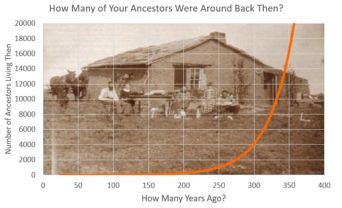
You can do it yourself! To open an eclipse portal, follow these steps:
1. Choose a the target time and place where the eclipse portal will go. If far in the past or future, you can assume that there was/will be an eclipse at some point there (say, at the mouth of the Nile river 20,000 years ago, or along the Ganges river 100,000 years in the future). Or, if a more recent or nearer future time is chosen, you can look up a specific eclipse – here are 5,000 years of past and future eclipses, with maps (click on the map link in red for the time period you are interested in – how about Southern Africa on December 31, in the year 2996?). You can get a good idea of some options described in the “Our Rich Eclipse History” section below. Also, remember that basic math shows that once you go a few centuries back, your number of Ancestors soars quickly, and so it’s easy to pick a place where your Ancestors experienced your target eclipse.
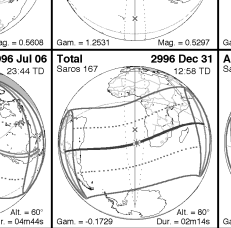 Eclipses have happened in all locations on earth, and will continue to do so to for another ~600 million years (they will no longer happen after that because the moon’s orbit is very slowly growing – a few centimeters each year, so in the far future the moon will be too far from us to appear large enough to block out the Sun). So one can open an eclipse portal to any time in Earth’s history, as well to the future Earth. How about an eclipse near when our first vertebrate Ancestors clambered onto land, ~400 million years ago? Or just a few years after the Chicxulub asteroid impact that wiped out the (non-avian) dinosaurs 66 million years ago, after which the Earth was covered with ferns and turtles? But not to other planets – Earth is the only planet in our Solar System on which one can stand and see a total solar eclipse (Mercury and Venus don’t even have moons, Mars’ moons are too small, one can’t stand on the gas giants, and Pluto isn’t a planet anymore).
Eclipses have happened in all locations on earth, and will continue to do so to for another ~600 million years (they will no longer happen after that because the moon’s orbit is very slowly growing – a few centimeters each year, so in the far future the moon will be too far from us to appear large enough to block out the Sun). So one can open an eclipse portal to any time in Earth’s history, as well to the future Earth. How about an eclipse near when our first vertebrate Ancestors clambered onto land, ~400 million years ago? Or just a few years after the Chicxulub asteroid impact that wiped out the (non-avian) dinosaurs 66 million years ago, after which the Earth was covered with ferns and turtles? But not to other planets – Earth is the only planet in our Solar System on which one can stand and see a total solar eclipse (Mercury and Venus don’t even have moons, Mars’ moons are too small, one can’t stand on the gas giants, and Pluto isn’t a planet anymore).

2. Learn/build details of that time and place. Now that you have your target time and place, take a little time to learn about what it was like then and there. The internet has a lot of information, as do libraries, etc. It’s OK if every detail isn’t known – you can make some creative but realistic best guesses about details you want but can’t find – like, say, clothing styles, feather color, landforms like hills, etc. Learn or build what details you need – see a very partial overview below. Do you want to decide now what you (and/or others) will see and hear, or let that strike you at the time?
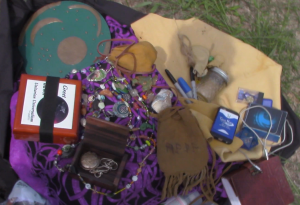
3. Decide when and where you will open the portal. Is this for a group ritual? Or for a solitary time? You can prepare a ritual just as you want it, or feel free to take and use this one here, ready to go, and some additional ritual ideas, like charging objects with eclipse power (such as your Cosmala, if you have one – or a special bead to put on your Cosmala when you make it). One of the things I charge with Eclipse Shadow is a jar of granulated salt – making a ritual tool, by which I can place just a tiny pinch of this salt in ritual water to make as much eclipse water as I want, at any time. Also, you might want to snap a picture of all you’ve charged – both to commemorate the event as well as for reference (notice the weird, waning sunlight in my picture, at right).
Is your eclipse portal part of events days before the eclipse? Or during the partial eclipse? Or in the few precious moments of totality? Will you ask others present to speak out what they see and hear, or will you describe everything yourself? Will you tell everyone when and where they are going? This planning can be done before Step 1 instead. Will this be part of a spiritual pilgrimage? If your plans for the eclipse itself aren’t already complete, all the practical details you need are at this link.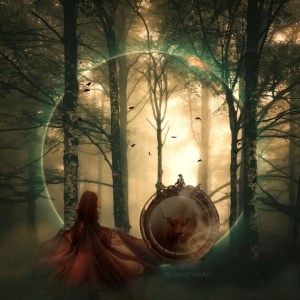
4. Prepare for the portal. Do you need anything other than your mind and voice? If this is in a ritual, will you wear anything to evoke the idea of the eclipse, maybe black? Do you feel like you can do this without notes, or should notes be prepared? Are there other parts of the ritual that need to be taken into consideration? Will you use these or other opening words?
Start: “The power of this eclipse I call, to open this portal and reach us all!”
End: “This time is brief and now must end, this eclipse’ gift to you I send.”
5. Open the portal! When the time comes, open your portal with your plan prepared in Step 4. As with all ritual activity, remember that you may be in a ritual mental state afterwards, and may need some time to come down.
Our Rich Eclipse History!
Looking back, thinking about our Ancestors’ (all the way back) responses to eclipses…Animals as simple as crickets “notice” a total eclipse – commencing their chirping as if it were night. But do they notice this as any different from a normal evening? I don’t know. Do animals like shrews and lemurs realize it’s something different? I would think that monkeys probably think that something is different from a normal nightfall – it’s much faster, and often at the “wrong” time of day – but do they barely notice, or do they freak out? I found some research – it sounds like their response is closer to “barely noticing” (this was for baboons, but I think that’s close enough), so Ancestors before primates probably saw this as an out of place “nightfall”.
OK, what about our Ancestors who were apes? Do they have the thinking minds that might react in a stronger way? It sounds like they do! This study (reported in the American Journal of Primatology) reports on chimps, with many of them looking up at the eclipse, and a child appearing to take special interest in it. It seems likely that our Ancestors 8 million years ago probably behaved similarly. Behaviors during eclipses don’t tend to fossilize well, so with no living creatures similar to Homo habilis, H. afrarenis, and others, we’ll have to jump ahead millions of years to humans.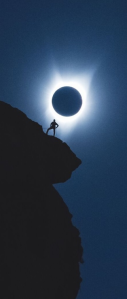
We know that many different cultures have noticed and written about eclipses for thousands of years – overwhelmingly in fear. What was it like for the hundreds of thousands of years from Homo erectus to modern humans at 200,000 years ago? With fearful responses from the first records we have, a reasonable guess seems to be growing fear, as our Ancestors became more and more aware of eclipses, and started to pass down stories of them. So many of those must have been terrifying! Imagine your world, on a flat earth, under the hard dome of the sky (like a planetarium), with no wide universe outside our sky. This little world is all that is, and suddenly, without warning, someone shouts out that the sun is being eaten. Worried shouts arise as people look through pinched fingers at the waning Sun and see the crescent in sun-dappled shadows. Panic spreads through the village – the Shaman is brought out – who is also confused and calling for action to appease the gods. But it’s no use – The crescents sharpen, and shrink. 30 minutes later, the village is plunged into darkness. Screams, wails, running, hiding, and perhaps violence follow for 90 agonizing seconds. Then sunlight returns. The fog of panic lifts, showing what state the village is in now. What is destroyed? Who is alive and who is dead? Was anyone killed so as to appease the Sun? Or is the Shaman praised because whatever she or he did has apparently worked, with the Sun now returning? As we evolved, and passed down stories, the time would come when we had stories of past eclipses. Did these stories sooth the panic, or did they worsen it? This could have been the state for thousands of years. Decades or centuries between eclipses in a world with a 40 year life expectancy and no written records means that eclipses are legendary stories from far-off lands, if they are heard at all. Each eclipse shatters the world without warning, and with no idea of what’s going on.
With life being a daily struggle, it’s no surprise that our species learned the motions of the stars and planets quickly. We thought it was a matter of life and death to know when Jupiter would go retrograde or the moon would be next to the Venus in the sky.
Then, one day, someone was mapping out the paths of the moon and sun, and noticed they’d intersect – what might she or he have thought? What confusion and curiosity sprang to mind, wondering what would happen? The day approached. Did this astronomer tell anyone? Tell the king or chief? What if I’m wrong? Now it’s 3 days away. 2 days away. What will happen tomorrow?!? Then, the eclipse. The realization that eclipses can be *predicted*!!! Rushing to calculate the next one – but nothing for decades! How to pass this on? How to convince great grandchildren to remember this method? How many times was this discovered, and lost? How many times was it discovered and kept?
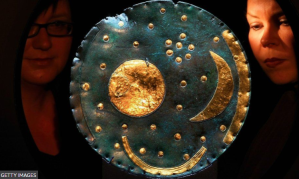 We don’t know. We know that more than 4,000 years ago, our Ancestors could predict eclipses. Let that sink in. Four thousand years!! We still thought the Earth was flat, that diseases were supernatural, we had no idea of that our hearts actually did, and who knowns what else, and we could predict eclipses! And likely even before 4,000 ya, as we have very few records from that far back.
We don’t know. We know that more than 4,000 years ago, our Ancestors could predict eclipses. Let that sink in. Four thousand years!! We still thought the Earth was flat, that diseases were supernatural, we had no idea of that our hearts actually did, and who knowns what else, and we could predict eclipses! And likely even before 4,000 ya, as we have very few records from that far back.
This is the world that gave us the Nebra Disk – our most ancient map of the night sky, depicted in gold and used by the high priests in their stone circles. A world where death at the hands of spirits could come any day, when the far lands might actually hold giants and monsters, when animals spontaneously grew from garbage, when there were no atoms or germs, and most of your world was a mystery.
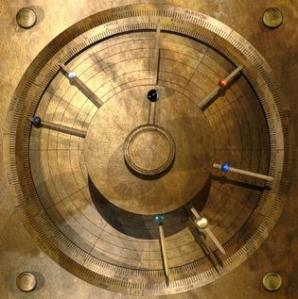 What was that rush of discovery like? I feel a tiny version of that in the lab when a formerly inexplicable process suddenly makes sense – but to have the ravaging terror of entire kingdoms suddenly fall under your predictive power?!? I can’t imagine what that was like – each of the many times it was independently discovered!
What was that rush of discovery like? I feel a tiny version of that in the lab when a formerly inexplicable process suddenly makes sense – but to have the ravaging terror of entire kingdoms suddenly fall under your predictive power?!? I can’t imagine what that was like – each of the many times it was independently discovered!
And that brings us to the past few thousand years. Eclipses are still feared, but now they are often predicted. Over 4,100 years ago, the Chinese emperor expected eclipses to be predicted, and when and eclipse happened without warning, he had his two royal astronomers (Hsi and Ho) beheaded for their failure.
Prediction became more reliable with practice. Did you know about the gear driven computer made by the ancient Greeks? It’s real! What purpose did this culture apply this pinnacle of its scientific achievement to? Why, the motions of the stars and planets, and predicting eclipses, of course! Here is a reconstruction of the Antikythera device , which was based on the original from a Greek shipwreck from over 2,000 years ago. What would our world be like today if the Dark Ages had not stopped our discovery of the natural world in its tracks just after this computer was invented?

On a side note, in most bibles, Mk 15:33 records “darkness falling over the land” in Jerusalem when Jesus was executed in the late morning, which was (near Passover, which is) within a few weeks after the Spring Equinox, around 33 C. E.. Looking at the data, it turns out that there was no total solar eclipse in Jerusalem then (and the gospel says the darkness lasted 3 hours, which isn’t possible for a total solar eclipse anyway). But whoever wrote “Mark’s” gospel of course wouldn’t know that we’d be able to so easily discover that his made up story is made up (nor would Lk and Mt, who copied this from Mk).
Eclipses still brought fear and terror until the scientific revolution just a few centuries ago removed most of the superstition and replaced it with knowledge and natural awe. Today we can calculate, to the millisecond, when and where eclipses happen for both thousands of years into the future and into the past, giving us this ritual tool of the eclipse portal. Here is a video to convey that wonder and awe – it can be a way to help others understand how incredible the experience of an total solar eclipse is.
For those of us with a naturalistic spirituality (as well as for many others), reality itself – and especially our Earth, Moon and Sun – give us many opportunities for sacred times. May your eclipse portal be one of those, along with of course, for many of us, the eclipse itself on April 8th. Though we can’t decide when the sacred will touch us, we can give it more opportunities. Blessed be.
The Author: Jon Cleland Host
Starstuff, Contemplating: We are assemblages of ancient atoms forged in stars – atoms organized by history to the point of consciousness, now able to contemplate this sacred Universe of which we are a tiny, but wondrous, part.

Dr. Jon Cleland Host is a scientist who earned his PhD in materials science at Northwestern University & has conducted research at Hemlock Semiconductor and Dow Corning since 1997. He holds eight patents and has authored over three dozen internal scientific papers and eleven papers for peer-reviewed scientific journals, including the journal Nature. He has taught classes on biology, math, chemistry, physics and general science at Delta College and Saginaw Valley State University. Jon grew up near Pontiac, and has been building a reality-based spirituality for over 30 years, first as a Catholic and now as a Unitarian Universalist, including collaborating with Michael Dowd and Connie Barlow to spread the awe and wonder of the Great Story of our Universe (see www.thegreatstory.org, and the blog at evolutionarytimes.org). Jon and his wife have four sons, whom they embrace within a Universe-centered, Pagan, family spirituality. He currently moderates the yahoo group Naturalistic Paganism.
See Starstuff, Contemplating posts.
See all of Dr. Jon Cleland Host’s posts.
 Naturalistic Paganism
Naturalistic Paganism

